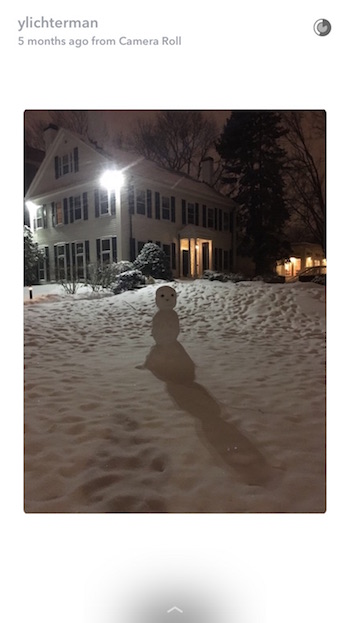
Snapchat on Wednesday unveiled Snapchat Memories, a new feature that lets users save and share snaps and other photos and video that they have saved to their phones.
 While some said Memories would make Snapchat more addictive and others fretted that it would ruin the app’s spontaneity, the new functionality will also likely change how news organizations use the app.
While some said Memories would make Snapchat more addictive and others fretted that it would ruin the app’s spontaneity, the new functionality will also likely change how news organizations use the app.
 With Memories, users can save snaps and then edit and resend them to other users or add them to their Snapchat Story. Users can also now upload photos and video that they’ve shot outside of Snapchat. However, saved photos and videos that are uploaded as stories or snaps have a timestamp to show when they were originally taken. Users can access Memories by swiping up from the camera section of the app.
With Memories, users can save snaps and then edit and resend them to other users or add them to their Snapchat Story. Users can also now upload photos and video that they’ve shot outside of Snapchat. However, saved photos and videos that are uploaded as stories or snaps have a timestamp to show when they were originally taken. Users can access Memories by swiping up from the camera section of the app.
Not everyone has access to Memories yet — Snapchat said it’s “rolling out Memories selectively over the next month or so” — so it’s too soon to say how it will exactly change how newsrooms use Snapchat. (I got access to Memories late Wednesday night, but none of my other Nieman Lab colleagues have it yet.)
Even though the feature is still so new, I asked a few publishers — Quartz, the Norwegian public broadcaster NRK, and The Hill — how they anticipate using Memories, what its potential is, and how it might change their Snapchat workflows. Here, lightly edited, is what they had to say over email:
Taylor Lorenz, The Hill director of emerging platforms:
Memories will make producing this type of content easier in the sense that it doesn’t have to all be done in real time, but harder in that I think it will raise the bar for repackaged content. Now that we have a longer lead time on creating these evergreen-type stories, the quality of what we put out on our channel should improve.
We will still cover certain big events live (like the White House Correspondents’ Dinner weekend), but may then re-up highlights from the event in a story later on. In this sense, it should extend the shelf life of our coverage.
In terms of workflow, I anticipate our social video producer having greater involvement in crafting stories. I imagine other organizations will be using resources like designers too, and content on news channels, including our own, will begin to look more branded and produced (like Snapchat Discover). I’m not sure this is what users want however, and I think the challenge will be to make content that’s still engaging and feels native to the feed as the aesthetic of the feed shifts.
As the look and feel of the feed evolves I also anticipate greater competition. Users will (potentially) be creating more stories themselves and, as Brian Feldman at New York astutely pointed out, our content will now be competing with viral aggregator accounts like “GreatVines.” We might experiment with aggregation ourselves, perhaps by creating a weekly story highlighting top political clips, or something like that.
I think this update marks a new era for Snapchat and it will be exciting to see how things shake out.
Jennifer Chang, Quartz growth editor:
It’s tough to say what we’d do with the Memories feature without first using it, but I can see it complementing our approach. We can take our audience to a place, show them something interesting, and then have the ability to return to that place to relive or revisit the story. For example, when we’re reporting on an ongoing news event like Brexit, our finance reporter in New York can use an old snap that a reporter in London had snapped earlier in the week to provide some necessary context, and in an environment that would otherwise be impossible to capture.
As for our Snapchat workflow, it is definitely an extra step for reporters but seems worth the time. We’d also like to experiment with resurfacing old Stories that an unusually large number of fans had missed, say, during a holiday weekend, or A/B test it with a potentially new framing.
Ståle Grut, NRKbeta journalist and consultant:
Ingvild Sættem Beltesbrekke at P3 News says it is a big advantage to be able to send out photos from our archives, but if they get a timestamp this might not be that useful. It could maybe make it easier to save and archive their news stories than it is today.